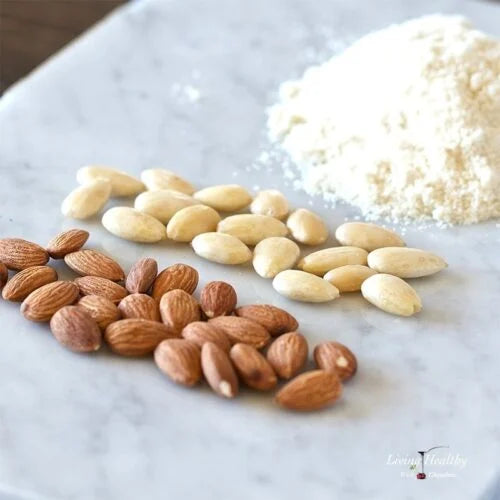Almond flour has gained immense popularity in the world of gluten-free and low-carb baking. However, not all almond flour is the same—there are two primary types: blanched and unblanched almond flour. Understanding the differences between the two can help you choose the best one for your recipes and dietary needs.
In this article, we’ll explore blanched vs unblanched almond flour as we uncover what sets them apart, their unique benefits and which one is better suited for different types of cooking and baking.
What is Almond Flour?
Almond flour is a gluten-free, grain-free alternative to wheat flour made from finely ground almonds. It is commonly used in baking, cooking, and thickening sauces due to its nutty flavour and nutritious profile.
There are two main types of almond flour:
-
Blanched Almond Flour – Made by removing the almond skins before grinding.
-
Unblanched Almond Flour – Made by grinding whole almonds with the skins intact.
Each type has its own unique texture, colour, taste, and nutritional composition, which affects the outcome of recipes.

Blanched Almond Flour: What is It?
Blanched almond flour is made by removing the brown skin of almonds before grinding them into a fine powder. This process gives the flour a lighter colour and smoother texture.
Key Characteristics of Blanched Almond Flour:
✔ Colour: Pale, off-white
✔ Texture: Fine and smooth
✔ Taste: Mild, slightly sweet
✔ Best For: Cakes, macarons, delicate pastries
How is Blanched Almond Flour Made?
-
Blanching: Almonds are boiled briefly to loosen their skins.
-
Peeling: The brown outer skin is removed.
-
Grinding: The peeled almonds are finely ground into flour.
Benefits of Blanched Almond Flour:
✅ Smooth Texture – Ideal for delicate baked goods.
✅ Neutral Flavour – Enhances the taste of cakes and pastries.
✅ Works Well in Recipes – Many recipes are specifically designed for blanched almond flour.
Best Uses for Blanched Almond Flour:
-
Macarons
-
Cakes and cupcakes
-
Pancakes and waffles
-
Bread and muffins
-
Thickening sauces

Unblanched Almond Flour: What is It?
Unblanched almond flour is made using whole almonds with the skins intact. This gives the flour a darker colour, a coarser texture, and a slightly more intense nutty flavour.
Key Characteristics of Unblanched Almond Flour:
✔ Colour: Light to dark brown
✔ Texture: Slightly coarse
✔ Taste: Rich, nutty, slightly earthy
✔ Best For: Rustic baked goods, bread, and coatings
How is Unblanched Almond Flour Made?
-
Grinding Whole Almonds: The almonds are ground with their skins still on.
-
Finely Milled: It is then processed to achieve a fine or coarse texture.
Benefits of Unblanched Almond Flour:
✅ Higher in Fibre – The almond skin adds extra fibre and nutrients.
✅ Richer Flavour – More intense nutty taste.
✅ Denser Texture – Great for hearty baked goods and coatings.
Best Uses for Unblanched Almond Flour:
-
Bread and biscuits
-
Brownies
-
Crusts for fish and chicken
-
Nutty-flavoured pancakes
You might also enjoy reading: Almond Flour vs Coconut Flour
Blanched vs Unblanched Almond Flour: A Detailed Comparison
|
Feature |
Blanched Almond Flour |
Unblanched Almond Flour |
|
Processing |
Skins removed before grinding |
Whole almonds ground with skins |
|
Colour |
Light, off-white |
Light to dark brown |
|
Texture |
Fine, smooth |
Slightly coarse |
|
Taste |
Mild, slightly sweet |
Rich, nutty, earthy |
|
Best For |
Cakes, macarons, pastries |
Bread, brownies, coatings |
|
Nutritional Value |
Lower fibre |
Higher fibre due to almond skins |
Which One Should You Choose?
Your choice between blanched vs unblanched almond flour depends on your recipe, texture preference, and dietary goals.
-
For light, fluffy baked goods: Use blanched almond flour.
-
For rustic, nutty recipes: Use unblanched almond flour.
-
For higher fibre intake: Choose unblanched almond flour.
If you are looking for a versatile flour that works in most baking recipes, blanched almond flour is the safest bet. However, if you want to maximise nutrition and flavour, unblanched almond flour is a great choice.

Where to Buy High-Quality Almond Flour?
At Sattvic Foods, we offer premium unblanched almond flour and almond meal, naturally gluten-free and rich in protein and fibre. Our flour is:
✔ Unblanched
✔ Naturally high in protein & fibre
✔ Perfect for baking & cooking
👉 Shop Our Unblanched Almond Flour and Defatted Almond Meal here
Conclusion
Both blanched and unblanched almond flour have unique properties, making them ideal for different uses. Blanched almond flour is best for delicate baking, while unblanched almond flour offers a higher fibre content and a more intense nutty flavour.
If you’re looking for a versatile and nutritious flour, unblanched almond flour is a fantastic choice, especially for those who love a heartier texture and extra health benefits.
FAQs
1. Is blanched almond flour healthier than unblanched?
Unblanched almond flour contains more fibre due to the almond skins, making it slightly more nutritious. However, both types are rich in protein and healthy fats.
2. Can I substitute blanched almond flour for unblanched in recipes?
Yes, but it may affect texture and appearance. Unblanched almond flour makes baked goods denser and darker, while blanched almond flour creates a lighter texture.
3. Does unblanched almond flour have a stronger taste?
Yes, it has a more pronounced nutty and earthy flavour due to the almond skins.
4. Is almond flour good for keto diets?
Yes! Both blanched and unblanched almond flour are low in carbs and high in healthy fats, making them ideal for keto-friendly recipes.
5. How should I store almond flour?
Store almond flour in an airtight container in a cool, dry place. For longer shelf life, refrigerate or freeze it.
-
Health Benefits of Almonds – WebMD
-
Almond Flour Nutrition Facts – Healthline
-
Almond Flour vs. Coconut Flour – Medical News Today

